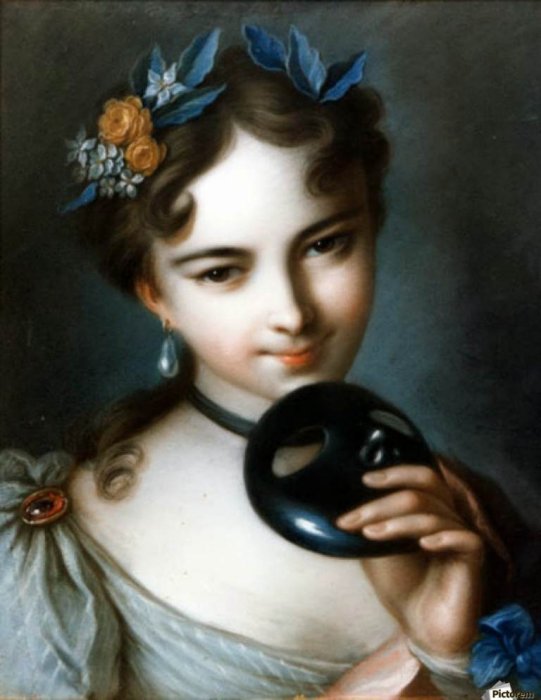Why Was The Moretta Mask So Popular?
Conny Waters – AncientPages.com - Flirting with a woman who wore a Moretta mask was a challenge for a man because she couldn't speak, and you had no idea what impression you made on her.
It's difficult to imagine the Moretta mask could become a modern fashion trend today.
Woman wearing a moretta in Pietro Longhi's The Rhinoceros. Credit: Public Domain
With a few exceptions, perhaps, most women like to show their beauty, but this unusual face coverage was prevalent about 300 years ago. Why is that?
Moretta Mask Became A Seduction Tool
Made of black velvet and hiding the woman's features, the Moretta mask was very popular in Venice in the 18th century. It was one of the most fascinating Venetian masks ever created.
It may sound like a contradiction that hiding your face would attract attention. Women usually want to show how attractive they can be, but the Moretta mask concealed the woman's actual treasure, her face.
By hiding her identity, a woman became more mysterious and thus more attractive. The problem with the man was that she couldn't talk. "A button held between the teeth, rendering the wearer mute. It's no wonder the moretta, meaning "dark," was also sometimes called the "servetta muta," or "mute servant." 1
A man had to try to win her favors without being able to talk to her, and if he succeeded, she would take off her mask and thus reveal herself to her cavalry.
"Removing the Moretta mask, the lady offered not only the longed-for sight of her face but also the sound of her voice, considered a faithful mirror of the soul. Only the truly fortunate had the privilege to admire that face and to hear her voice, but it would have taken a brave man to seduce a woman without knowing what he was getting - as well as bold since he would have had to convince her to reveal her secret." 2
Charles-Antoine Coypel - 1745- Credit: Public Domain
The reasoning behind hiding your face and wearing the Moretta mask was simply different in those days. The Moretta mask was undoubtedly a powerful seduction tool, but it also had other purposes.
Moretta Mask Could Be Used To Protect Skin Or Charges Of Being Immodest
In France, women didn't always wear hats, and using the mask offered them protection against the sun. In those days, it was very fashionable to have pale skin safely.
James H. Johnson, Professor of History at Boston University, said the Moretta mask helped a woman hide her identity and avoid slander. In Paris, upper-class ladies rarely walked alone in public. Women who walked alone on the streets were often prostitutes, and any high-class lady would do anything to avoid being labeled a prostitute. By covering her face with a Moretta mask, she should walk wherever she pleased without risking her reputation.
The Moretta mask offered both freedom of movement and psychic space, as Professor Johnson explained. In modern days we sometimes wear "sunglasses, not to disguise ourselves but to create a kind of psychic distance so that we don't have to acknowledge people if we don't want to." 2
By wearing the Moretta mask, a woman could protect a psychic space when she didn't have physical space.
Long Tradition And Fascination With Masks In Venice
In his book, Venice Incognito: Masks in the Serene Republic, Professor Johnson writes that "starting in the late seventeenth century, Venetians wore masks in public for six months of the year, a practice they continued until the Republic's fall in 1797."
The Venetian carnival tradition is most famous for its distinctive masks. Credit: Frank Kovalchek, CC BY 2.0
Venetians' interest in masks goes far back in time, and though women only used the Moretta mask, there were other masks that men could wear.
"Masks were the public face of Venice in the eighteenth century. They were also present in less visible ways. Intellectuals spoke of "honest dissimulation," which called a partial truth—as opposed to a half-lie—morally justified.
Artists depicted allegorical masks both to condemn and recommend, with connotations far beyond the mere deceit or disguise that modern misreadings see.
Women masked their faces with veils, which granted liberty under the guise of protecting modesty. Beggars whose identities were known wore masks to hide their shame. When an economic crisis opened gaping disparities among elites, they clung to a tradition of identical dress to mask the inequality.
In early modern Venice, masks served purposes that did not depend on anonymity. Their use defies modern notions that identify masks with deception or a mocking rejection of hierarchy. Masking in Venice was often conservative, preserving distance, guarding status, and permitting contact among unequal through fictive concealment. Rather than obscuring identities, masks affirmed their permanence." 3
Today we associate masks with theater or carnivals, but covering your face partly or entirely was popular and sometimes also needed not so long ago.
Written by Conny Waters – AncientPages.com Staff Writer
Updated on February 12, 2023
Copyright © AncientPages.com All rights reserved. This material may not be published, broadcast, rewritten or redistributed in whole or part without the express written permission of AncientPages.com
Expand for referencesMore From Ancient Pages
-
 Secret Ancient Knowledge Of Portals Leading To Unknown Realms – Mysteries Of The Past And Present – Part 2
Featured Stories | Dec 7, 2021
Secret Ancient Knowledge Of Portals Leading To Unknown Realms – Mysteries Of The Past And Present – Part 2
Featured Stories | Dec 7, 2021 -
 Mysterious Biblical Celestial City And Its Connection To The North Star – The Arrival – Part 2
Biblical Mysteries | Feb 26, 2021
Mysterious Biblical Celestial City And Its Connection To The North Star – The Arrival – Part 2
Biblical Mysteries | Feb 26, 2021 -
 Denisovan Family Tree: New Branches Revealed In Ancient DNA
Archaeology | Apr 12, 2019
Denisovan Family Tree: New Branches Revealed In Ancient DNA
Archaeology | Apr 12, 2019 -
 Mysterious Mohenjo Daro Was Home To An Unknown Advanced Civilization Far Ahead Of Its Time
Civilizations | Apr 2, 2014
Mysterious Mohenjo Daro Was Home To An Unknown Advanced Civilization Far Ahead Of Its Time
Civilizations | Apr 2, 2014 -
 Illuminati: Facts And History About The Secret Society
Featured Stories | Mar 30, 2017
Illuminati: Facts And History About The Secret Society
Featured Stories | Mar 30, 2017 -
 On This Day In History: Riot Over Wine In Oxford – On Feb 10, 1355
News | Feb 10, 2017
On This Day In History: Riot Over Wine In Oxford – On Feb 10, 1355
News | Feb 10, 2017 -
 Phurba Dagger: Magical Weapon That Restrains Evil And Harmful Occult Forces
Artifacts | Mar 16, 2019
Phurba Dagger: Magical Weapon That Restrains Evil And Harmful Occult Forces
Artifacts | Mar 16, 2019 -
 Ancient Artifacts Used In Magical Rituals To Ward Off The Evil Eye Found Next To The Pilgrimage Road
Archaeology | Sep 11, 2023
Ancient Artifacts Used In Magical Rituals To Ward Off The Evil Eye Found Next To The Pilgrimage Road
Archaeology | Sep 11, 2023 -
 The Mysterious Books Of Prophecies Of The Knights Templar – Where Are They Hidden?
Featured Stories | Mar 26, 2022
The Mysterious Books Of Prophecies Of The Knights Templar – Where Are They Hidden?
Featured Stories | Mar 26, 2022 -
 Teens Make Incredible Discovery In An Ancient Florida Cave
Featured Stories | Mar 15, 2024
Teens Make Incredible Discovery In An Ancient Florida Cave
Featured Stories | Mar 15, 2024 -
 Voynich Manuscript: Ancient Book Nobody Is Able To Read
Artifacts | Jun 24, 2013
Voynich Manuscript: Ancient Book Nobody Is Able To Read
Artifacts | Jun 24, 2013 -
 Athena – Goddess Of Wisdom Delivered Punishments And Gifts
Featured Stories | Dec 31, 2018
Athena – Goddess Of Wisdom Delivered Punishments And Gifts
Featured Stories | Dec 31, 2018 -
 Mysterious Deaths In A Dangerous Valley May Be Related To Ancient Events
Featured Stories | Mar 14, 2022
Mysterious Deaths In A Dangerous Valley May Be Related To Ancient Events
Featured Stories | Mar 14, 2022 -
 Riddle Of Orkney’s Lost Tomb – Fascinating Neolithic Discovery
Featured Stories | Nov 15, 2023
Riddle Of Orkney’s Lost Tomb – Fascinating Neolithic Discovery
Featured Stories | Nov 15, 2023 -
 Crusader-Era Sword Discovered At Previously Unknown Burial Site In Finland
Archaeology | Oct 16, 2023
Crusader-Era Sword Discovered At Previously Unknown Burial Site In Finland
Archaeology | Oct 16, 2023 -
 On This Day In History: Most Unusual Emperor Renzong Of Song Dynasty Was Born – On May 30, 1010
News | May 30, 2016
On This Day In History: Most Unusual Emperor Renzong Of Song Dynasty Was Born – On May 30, 1010
News | May 30, 2016 -
 Ancient Secrets Of Mistletoe – Sacred Celtic Plant With Magical Powers
Ancient Traditions And Customs | Dec 2, 2017
Ancient Secrets Of Mistletoe – Sacred Celtic Plant With Magical Powers
Ancient Traditions And Customs | Dec 2, 2017 -
 Mysterious Ancient Village In A Prehistoric Anomalous Zone – Unexplained Sightings And Sounds – Part 1
Featured Stories | Jul 27, 2020
Mysterious Ancient Village In A Prehistoric Anomalous Zone – Unexplained Sightings And Sounds – Part 1
Featured Stories | Jul 27, 2020 -
 200,000-Year-Old Grass Bed Discovered In South Africa’s Border Cave
Archaeology | Aug 14, 2020
200,000-Year-Old Grass Bed Discovered In South Africa’s Border Cave
Archaeology | Aug 14, 2020 -
 Civita di Bagnoregio – Magnificent 2,500-Year-Old Etruscan City In The Sky Is Struggling To Survive
Featured Stories | Jun 23, 2021
Civita di Bagnoregio – Magnificent 2,500-Year-Old Etruscan City In The Sky Is Struggling To Survive
Featured Stories | Jun 23, 2021



